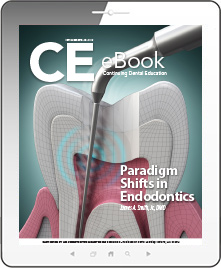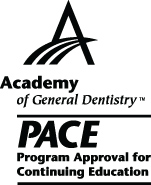CDEWorld > eBooks > Paradigm Shifts in Endodontics


ADA CERP is a service of the American Dental Association to assist dental professionals in identifying quality providers of continuing dental education. ADA CERP does not approve or endorse individual courses or instructors, nor does it imply acceptance of credit house by boards of dentistry. Concerns or complaints about a CE provider may be directed to the provider or to ADA CERP at www.ada.org/cerp/

Approved PACE Program Provider. FAGD/MAGD credit. Approval does not imply acceptance by a state or provincial board of dentistry, or AGD endorsement. 1/1/2023 to 12/31/2028. ID # 209722.
eBook
Released: Monday, October 15, 2018
Expires: Friday, April 30, 2021
Paradigm Shifts in Endodontics
By James A. Smith, Jr., DMD
Commercial Supporter: Sonendo
The specialty of endodontics has been particularly impacted by distinct technological advances enabling the trained practitioner to become a better diagnostician and deliver a high level of patient care. The dental operating microscope and cone-beam computed tomography are two technologies that have significantly improved the quality and quantity of information available to the clinician. In addition, new systems employ ultrasonic laser, and, more recently, broad spectrum acoustic technology to improve successful cleaning and disinfection of the root canal anatomy. Each of these advances has contributed to a critical shift in endodontic practice.
LEARNING OBJECTIVES:
-
Describe three technological advances that have advanced endodontics over the last 3 decades.
-
Discuss how each of these technological advances specifically impacts the clinical practice of endodontics.
-
Explain the complications involved in cleaning and disinfecting the root canal system.
About the Author
Dr. James A. Smith, Jr., DMD, Private Practice, Adjunct Assistant Professor, School of Dentistry, University of Alabama at Birmingham, Birmingham, Alabama
Download FREE eBook now!

